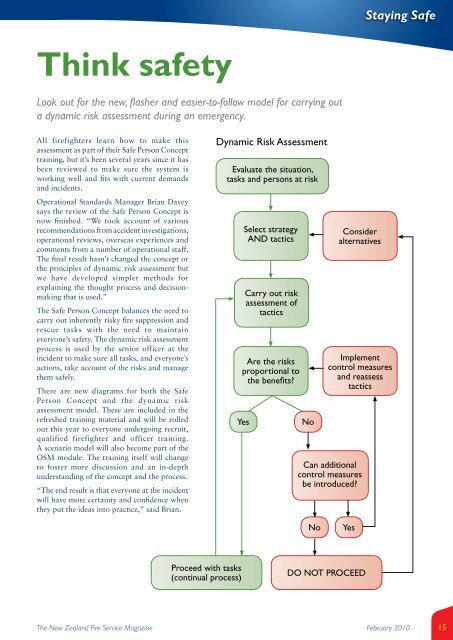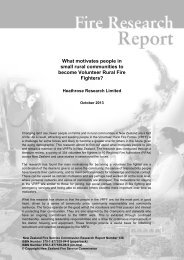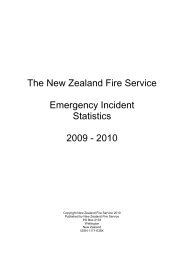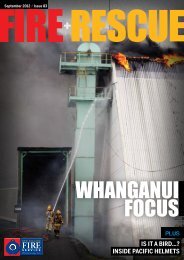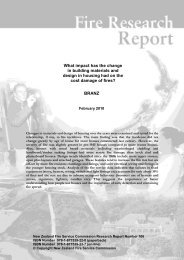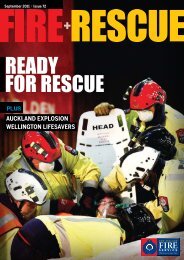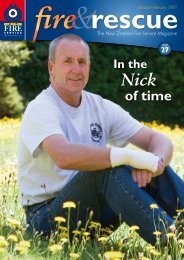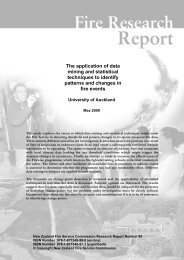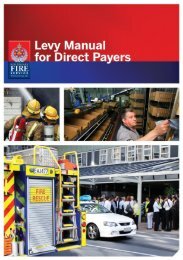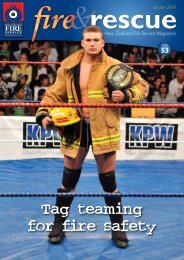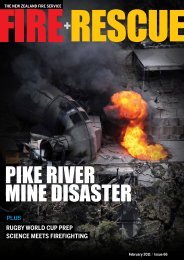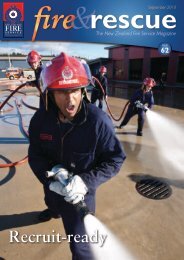Issue 56 - New Zealand Fire Service
Issue 56 - New Zealand Fire Service
Issue 56 - New Zealand Fire Service
You also want an ePaper? Increase the reach of your titles
YUMPU automatically turns print PDFs into web optimized ePapers that Google loves.
Think safety<br />
Look out for the new, flasher and easier-to-follow model for carrying out<br />
a dynamic risk assessment during an emergency.<br />
All firefighters learn how to make this<br />
assessment as part of their Safe Person Concept<br />
training, but it’s been several years since it has<br />
been reviewed to make sure the system is<br />
working well and fits with current demands<br />
and incidents.<br />
Operational Standards Manager Brian Davey<br />
says the review of the Safe Person Concept is<br />
now finished. “We took account of various<br />
recommendations from accident investigations,<br />
operational reviews, overseas experiences and<br />
comments from a number of operational staff.<br />
The final result hasn’t changed the concept or<br />
the principles of dynamic risk assessment but<br />
we have developed simpler methods for<br />
explaining the thought process and decisionmaking<br />
that is used.”<br />
The Safe Person Concept balances the need to<br />
carry out inherently risky fire suppression and<br />
rescue tasks with the need to maintain<br />
everyone’s safety. The dynamic risk assessment<br />
process is used by the senior officer at the<br />
incident to make sure all tasks, and everyone’s<br />
actions, take account of the risks and manage<br />
them safely.<br />
There are new diagrams for both the Safe<br />
Person Concept and the dynamic risk<br />
assessment model. These are included in the<br />
refreshed training material and will be rolled<br />
out this year to everyone undergoing recruit,<br />
qualified firefighter and officer training.<br />
A scenario model will also become part of the<br />
OSM module. The training itself will change<br />
to foster more discussion and an in-depth<br />
understanding of the concept and the process.<br />
“The end result is that everyone at the incident<br />
will have more certainty and confidence when<br />
they put the ideas into practice,” said Brian.<br />
The <strong>New</strong> <strong>Zealand</strong> <strong>Fire</strong> <strong>Service</strong> Magazine<br />
Proceed with tasks<br />
(continual process)<br />
Dynamic Risk Assessment<br />
Evaluate the situation,<br />
tasks and persons at risk<br />
Select strategy<br />
AND tactics<br />
Carry out risk<br />
assessment of<br />
tactics<br />
Are the risks<br />
proportional to<br />
the benefits?<br />
Yes No<br />
Can additional<br />
control measures<br />
be introduced?<br />
No<br />
Consider<br />
alternatives<br />
Implement<br />
control measures<br />
and reassess<br />
tactics<br />
Yes<br />
DO NOT PROCEED<br />
Staying Safe<br />
February 2010<br />
15


